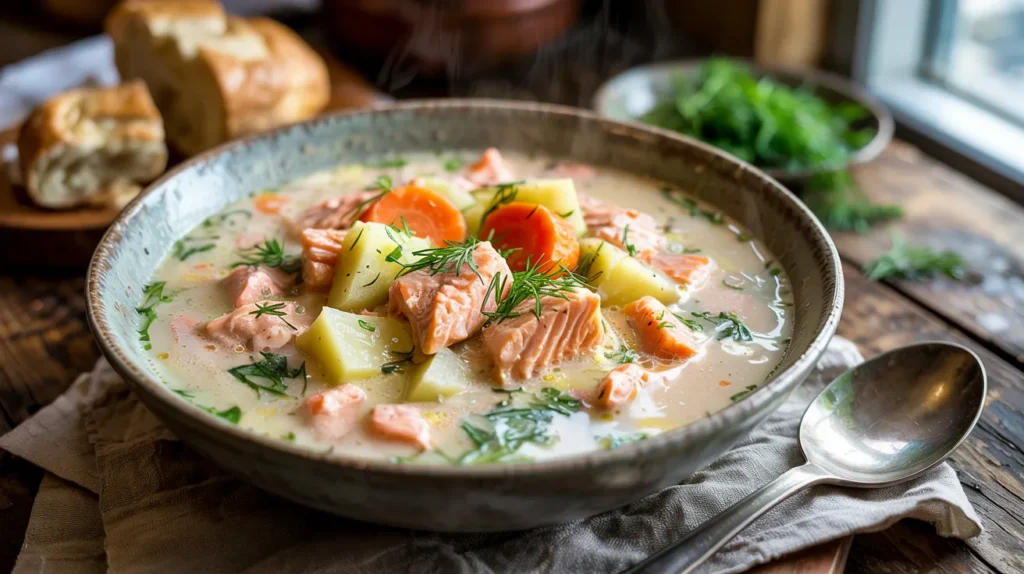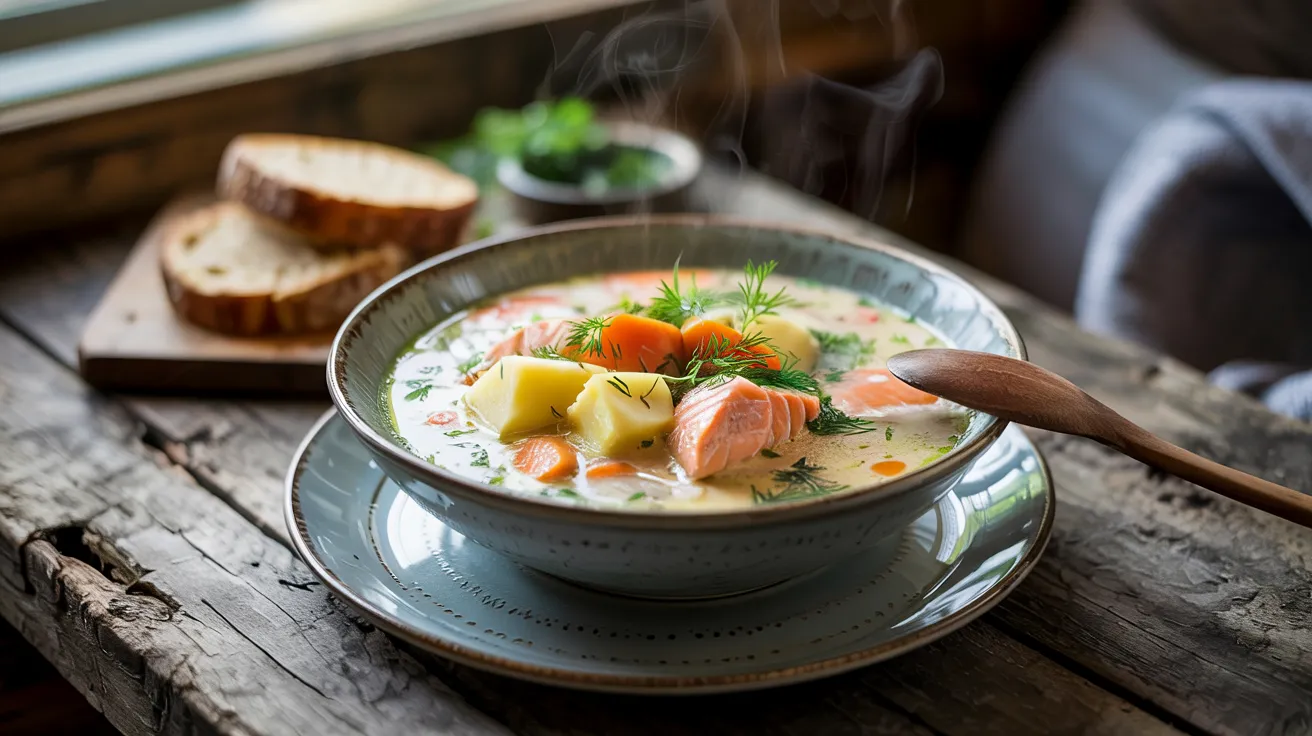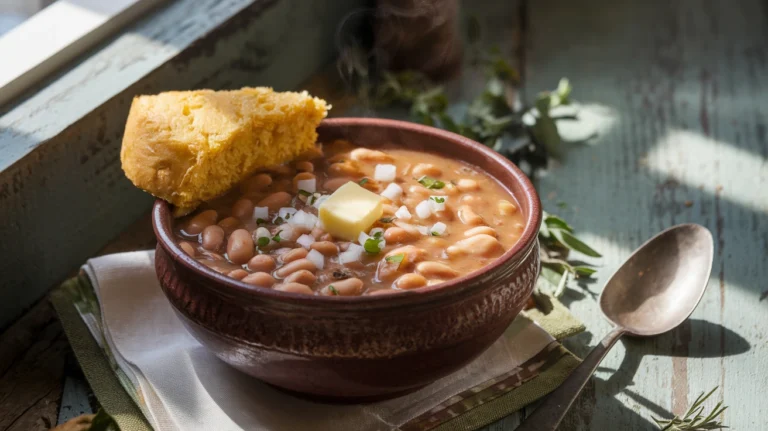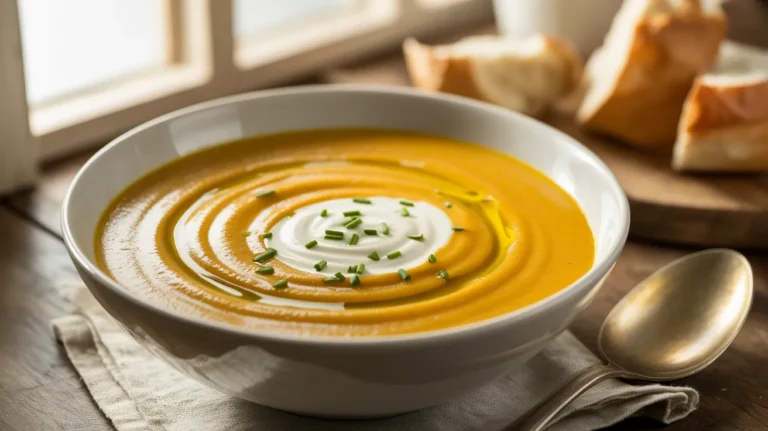This traditional Finnish salmon soup brings together tender salmon, hearty potatoes, and fresh dill in a luxuriously creamy broth that’s both comforting and elegant. Our authentic Finnish salmon soup recipe transforms simple ingredients into a restaurant-quality meal that’s surprisingly easy to master at home, even for complete beginners.
SERVES: 4 | PREP: 20 MIN | COOK: 25 MIN | TOTAL: 45 MIN
Ingredients
Fresh Proteins
- 1 lb fresh salmon fillet, skin removed, cut into 1-inch cubes
- 2 cups whole milk
- 1 cup heavy cream
Vegetables & Aromatics
- 3 medium Yukon Gold potatoes (about 1 lb), peeled and diced
- 1 large yellow onion, finely chopped
- 2 medium carrots, sliced into rounds
- 3 cloves garlic, minced
- 3 tablespoons fresh dill, chopped (plus extra for garnish)
Pantry Staples
- 3 tablespoons butter
- 2 tablespoons all-purpose flour
- 4 cups fish stock (or chicken broth)
- 1 bay leaf
- 1 teaspoon salt (or to taste)
- ½ teaspoon white pepper
- 2 tablespoons lemon juice
Complete Step-by-Step Finnish Salmon Soup Instructions
Phase 1: Preparation Work (8 minutes)
Step 1: Prepare Your Salmon Remove the salmon from the refrigerator and place it on a clean cutting board. Using a sharp chef’s knife, carefully remove any remaining skin by sliding the knife between the flesh and skin at a 45-degree angle. Cut the salmon into uniform 1-inch cubes—this size ensures even cooking without the pieces falling apart. Look for any small bones by running your fingers along each piece and remove them with tweezers or needle-nose pliers. Pat each salmon cube completely dry with paper towels. This step is crucial because wet fish will steam rather than gently poach in your Finnish salmon soup, and excess moisture will dilute the flavors you’re building.
Step 2: Prep Your Vegetables
Wash and peel the potatoes using a vegetable peeler. Cut them into ¾-inch uniform cubes—measure the first few pieces to get the right size, then use those as your guide. Smaller pieces will break down and make your soup mushy, while larger pieces won’t cook through properly. Place the diced potatoes in a bowl of cold water to prevent browning while you prep the other vegetables.
Step 3: Prepare Aromatics Peel the onion and cut it in half from top to bottom. Lay each half flat and make horizontal cuts, then vertical cuts to create a fine dice—about ¼-inch pieces. The smaller you dice the onion, the smoother your soup base will be. Peel the carrots and slice them into ¼-inch rounds. Peel the garlic cloves and mince them finely—you can use a garlic press if you prefer. Wash the fresh dill and pat it dry, then chop it roughly. Set all prepared vegetables aside in separate bowls.
Phase 2: Building the Flavor Base (10 minutes)
Step 4: Start Your Base Place a large, heavy-bottomed soup pot (at least 4-quart capacity) on your stove over medium heat. The heavy bottom is important because it distributes heat evenly and prevents scorching when you add the cream later. Add the 3 tablespoons of butter and let it melt completely. You’ll know it’s ready when the butter starts to foam and sizzle gently—this should take about 1-2 minutes.
Step 5: Cook the Onions Add the diced onions to the melted butter and stir with a wooden spoon to coat them evenly. Cook for 3-4 minutes, stirring occasionally, until the onions become translucent and soft. They should not brown—if they start to brown, reduce your heat to medium-low. The onions are ready when you can easily pierce them with a fork and they’ve lost their sharp, raw smell.
Step 6: Add Garlic and Carrots Add the minced garlic and sliced carrots to the pot with the onions. Stir everything together and cook for another 2 minutes. You’ll smell the garlic becoming fragrant—this is exactly what you want. Don’t let the garlic brown, as it will become bitter. The carrots will start to soften slightly and their color will become more vibrant.
Phase 3: Creating the Thickening Base (5 minutes)
Step 7: Make the Roux Sprinkle the 2 tablespoons of flour evenly over the vegetables in your pot. Using your wooden spoon, stir constantly for 1-2 minutes to cook the flour. This process, called making a roux, will thicken your Finnish salmon soup and prevent it from being watery. You’ll see the flour coating all the vegetables and forming a paste-like consistency. Cook until the raw flour smell disappears—this is crucial for avoiding a floury taste in your finished soup.
Step 8: Add Stock Gradually This step requires patience and constant stirring. Pour in about ½ cup of the fish stock while stirring continuously with your wooden spoon. The mixture will look lumpy at first—this is normal. Keep stirring until smooth, then add another ½ cup of stock, stirring until smooth again. Continue this process, adding the stock in small increments while stirring, until all 4 cups are incorporated. This gradual method prevents lumps from forming and ensures a silky smooth base for your soup.
Phase 4: Cooking the Vegetables (12 minutes)
Step 9: Add Potatoes and Seasoning Drain the potatoes from their water and add them to the pot along with the bay leaf. The bay leaf adds a subtle earthy flavor that complements the salmon. Stir gently to combine everything. Bring the mixture to a gentle simmer—you should see small bubbles breaking the surface, but not a rolling boil. If it starts boiling vigorously, reduce the heat to medium-low.
Step 10: Simmer the Vegetables Cook for 8-10 minutes, stirring occasionally, until the potatoes are fork-tender. Test doneness by piercing a potato cube with a fork—it should go through easily but the potato should still hold its shape. If the potatoes start to break apart, they’re overcooked. During this time, the soup will thicken slightly from the potato starch, which is exactly what you want for authentic Finnish salmon soup.
Phase 5: Adding the Creamy Elements (6 minutes)
Step 11: Reduce Heat for Dairy This is a critical step that beginners often miss. Reduce your heat to low—the soup should barely be simmering with just occasional small bubbles. If the heat is too high when you add dairy, it will curdle and ruin your soup. Wait 1-2 minutes for the temperature to drop before proceeding.
Step 12: Add Milk First Slowly pour in the 2 cups of milk while stirring gently with your wooden spoon. Add it in a thin, steady stream rather than all at once. This gradual addition helps prevent temperature shock that could cause curdling. Stir continuously as you add the milk, and you’ll see the soup becoming creamy and lighter in color.
Step 13: Add Heavy Cream
Pour in the 1 cup of heavy cream using the same slow, steady method while stirring. The soup should now have a beautiful, creamy appearance. Never let the soup boil after adding the dairy—keep it at a gentle simmer with just tiny bubbles around the edges of the pot. If it starts to boil, immediately reduce the heat or remove from heat temporarily.
Step 14: Season the Base Add the 1 teaspoon of salt and ½ teaspoon of white pepper. White pepper is traditional in Finnish salmon soup because it provides warmth without black specks that would detract from the soup’s clean appearance. Stir gently to distribute the seasonings. Taste the soup with a clean spoon—it should be creamy, well-seasoned, and aromatic.
Phase 6: Cooking the Salmon to Perfection (5 minutes)
Step 15: Add Salmon Gently Carefully add the salmon cubes to the simmering soup one piece at a time. Don’t dump them all in at once, as this could cause splashing and temperature shock. Use a spoon to gently submerge each piece. The salmon will initially look bright orange or pink, depending on the variety you’re using.
Step 16: Poach the Salmon Cook for 3-4 minutes without stirring aggressively. Instead, use a gentle folding motion with your spoon to occasionally move the soup around the salmon, not the salmon around the soup. You’ll see the salmon gradually changing color from bright orange/pink to a lighter, more opaque color. The salmon is done when it flakes easily with a fork but still holds together in chunks.
Step 17: Final Flavor Additions Remove the bay leaf using a spoon or tongs—it’s served its purpose and can be bitter if bitten into. Stir in the fresh chopped dill and lemon juice. The dill should be bright green and fragrant, while the lemon juice will brighten all the flavors and complement the salmon’s richness. Add these at the very end to preserve their fresh flavors.
Step 18: Final Taste and Adjust Taste your Finnish salmon soup with a clean spoon and adjust seasoning as needed. You might need a bit more salt, a squeeze more lemon juice, or an extra pinch of white pepper. The soup should taste creamy, rich, and balanced with the salmon flavor shining through and the dill providing freshness.
Chef’s Notes for Perfect Finnish Salmon Soup
• Choose the right salmon: Wild-caught salmon has firmer texture and won’t fall apart as easily as farm-raised. If using frozen, thaw completely and pat very dry before cutting.
• Control the temperature: Keep the Finnish salmon soup at a gentle simmer once cream is added. High heat will cause the dairy to separate and ruin the smooth texture.
• Fresh dill is essential: Dried dill lacks the bright, grassy flavor that makes this soup authentic. Add it at the end to preserve its delicate taste.
• Make it ahead friendly: Prepare the base through step 14, then add salmon and finish when ready to serve. This prevents overcooking the fish during reheating.
Nutrition Information (Per Serving)
- Calories: 485
- Protein: 28g
- Carbohydrates: 24g
- Fat: 32g
- Fiber: 3g
- Sodium: 890mg
Delicious Finnish Salmon Soup Variations
Mediterranean Twist
Replace dill with fresh basil and add sun-dried tomatoes. The flavors complement salmon beautifully, similar to the aromatic profiles found in our tom yum talay recipe.
Smoky Version
Use smoked salmon instead of fresh, adding it in the last minute of cooking. Reduce salt accordingly as smoked fish is already seasoned.
Lighter Option
Substitute half-and-half for heavy cream and use low-fat milk. The soup will be less rich but still creamy and satisfying.
Hearty Winter Style
Add corn kernels and bacon bits for extra substance, creating a comfort food experience reminiscent of our loaded baked potato soup.
Storage & Reheating Your Finnish Salmon Soup
Refrigerator: Store Finnish salmon soup for up to 3 days in airtight containers. The flavors actually improve overnight as they meld together.
Freezing: Not recommended due to the cream base, which separates when frozen and thawed.
Reheating: Warm gently over low heat, stirring frequently. Add a splash of milk if the soup has thickened. Never microwave on high power—use 50% power and stir every 30 seconds.

Finnish Salmon Soup Troubleshooting Guide
Problem: Soup is too thin Solution: Mix 1 tablespoon cornstarch with 2 tablespoons cold milk. Stir into simmering soup and cook 2 minutes until thickened.
Problem: Cream has curdled
Solution: Remove from heat immediately and whisk vigorously. If severe, strain through fine-mesh sieve and start cream addition over.
Problem: Salmon is tough and dry Solution: You’ve overcooked it. Next time, add salmon in final 3-4 minutes and watch carefully for opaque color change.
Problem: Soup tastes bland Solution: Add more lemon juice and salt. The acid brightens all flavors. Fresh dill added just before serving also helps.
Problem: Potatoes are falling apart Solution: Use waxy potatoes like Yukon Gold, not russets. Cut uniformly and don’t overcook during the simmering phase.
Equipment Essentials
- Heavy-bottomed soup pot (4-6 quart capacity)
- Sharp chef’s knife for clean vegetable cuts
- Wooden spoon for gentle stirring
- Fine-mesh strainer (backup for curdled cream)
- Measuring cups and spoons
- Cutting board with groove for salmon prep
Shopping List
Seafood Counter
- 1 lb fresh salmon fillet, skin removed
Dairy Section
- Whole milk (2 cups needed)
- Heavy cream (1 cup needed)
- Butter (3 tablespoons needed)
Produce Section
- 3 medium Yukon Gold potatoes
- 1 large yellow onion
- 2 medium carrots
- 1 head garlic
- Fresh dill bunch
- 1 lemon
Pantry/Dry Goods
- All-purpose flour
- Fish stock or chicken broth
- Bay leaves
- Salt and white pepper
Success Secrets for Perfect Finnish Salmon Soup
1. Temperature control is everything—keep heat at medium or lower once dairy is added to prevent curdling and maintain silky texture.
2. Pat salmon completely dry before adding to prevent excess water from diluting your carefully built flavors.
3. Add dill at the very end to preserve its bright, fresh flavor that makes Finnish salmon soup so distinctive and aromatic.
4. Use fish stock when possible instead of chicken broth—it enhances the salmon flavor and creates more authentic taste.
5. Let the soup rest 5 minutes before serving to allow flavors to marry and temperature to stabilize for the perfect first spoonful.




